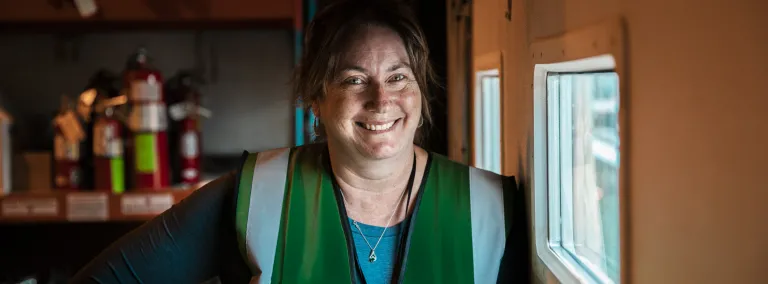Supporting science from the South Pole to South Dakota
Thompson’s career took her from IceCube Neutrino Observatory in Antarctica to supporting underground science at Sanford Lab
Those who opt into a career supporting science can bet they will end up in some incredible places. For Susan Thompson, who grew up in the temperate climes of San Diego, science-support roles took her to two extremes—atop two miles of Antarctic ice in the South Pole and a mile below the Black Hills of South Dakota.
We recently talked with Thompson about her unusual career path—from working on the IceCube Neutrino Observatory in the South Pole to being a warehouse specialist at Sanford Underground Research Facility (Sanford Lab) in Lead, SD — and the particles that seem to follow her wherever she goes. The interview has been condensed and edited for clarity.
You grew up in the San Diego area. What took you to the South Pole?
I grew up thinking that San Diego had the most boring weather: clear and between 70-85 degrees. Little rain, no thunderstorms and snow only in the mountains. From an early age, I wanted to experience places where not many people had been. Anytime I could get on a plane, I wanted to.
My first adventure was Alaska. I worked for the National Parks Service at Katmai National Park. From there, I traveled with the Red Cross and AmeriCore. I met a couple in New Zealand who told me about a research station at the South Pole. They said you could support the science through contract work. I had that idea stashed in the back of my head for a while. When I thought the timing was right, I decided to go for a job down there.
That's when my degree in urban planning helped me. I got a job for the solid waste department. In 1998, I became a trashman in Antarctica.
What was weather like there?
My first season was just over the summer, to dip my toes in. Right away, I knew I wanted to come back for winter. Over the course of nine years, I spent three winters there.
There are two stations. McMurdo Station is on the coastline of the continent. The temperature is usually -20 degrees. The warmest day was 35 degrees, so it did get above freezing. During the summer, the ice breaks up, and you can see the ground. There are several flights out each day. You have internet connection. You still feel connected to the rest of the world.
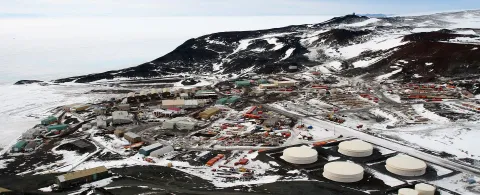
The South Pole station is, as you can imagine, more remote. It’s located atop two miles of ice. There, they wait for it to get above -50 degrees just to land a plane, otherwise the hydraulics freeze up. In the winter, it gets below -100 degrees. You only have internet for a few hours a day, when the satellite has line of sight. There is a lot of wind. In 1999, they began building a new station, the Elevated Amundsen–Scott South Pole Station, because the original Buckminster Fuller geodesic dome was being completely buried by drifts of snow. The new station had hydraulic legs that could lift when the winds came, letting the snow blow right underneath the building.
Still, I always worked outside, even at the South Pole, even in the winter.
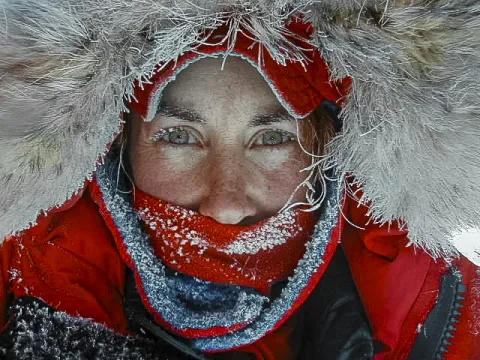
At McMurdo, there are streetlights. In the South Pole, there was only one red light over the door of the station. When the moon wasn't out, it was extremely dark. I probably saw the Southern Lights every other day.
What was supporting science like in Antarctica?
My background isn’t science. Much like Sanford Lab, a small percent of the population are scientists, while the majority of the population are those who support science. You have people who do construction, cooking, dishes and collect garbage.
After my two seasons in solid waste, I was in the logistics department. Everything arrived on either a plane or a boat. That makes logistics quite complicated. Each delivery had to arrive on a ship, then be offloaded and stored, then loaded onto a plane and flown to the South Pole. By the time supplies arrived, the teams had been waiting a long time for these deliveries, so we worked quickly to get them into the right hands.
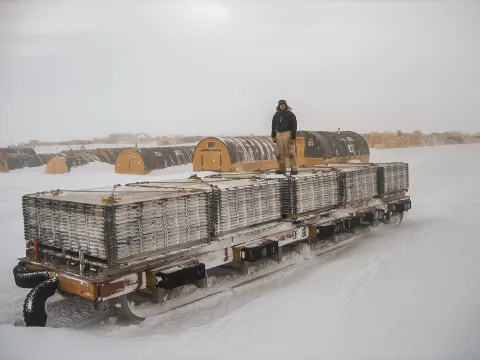
Later, I started working for the University of Wisconsin (UW), directly with the IceCube experiment. The actual science was beyond me, but I was very interested in the mechanics of it.
With UW, I was considered a hot water driller. The project required installing the DOMs (Digital Optical Modules) deep inside the ice. We took ice, turned it into hot water and sent it down a pressurized hose. This created a hole that reached two miles into the ice, where they installed the DOMs. Now the experiment is taking data from those DOMs.
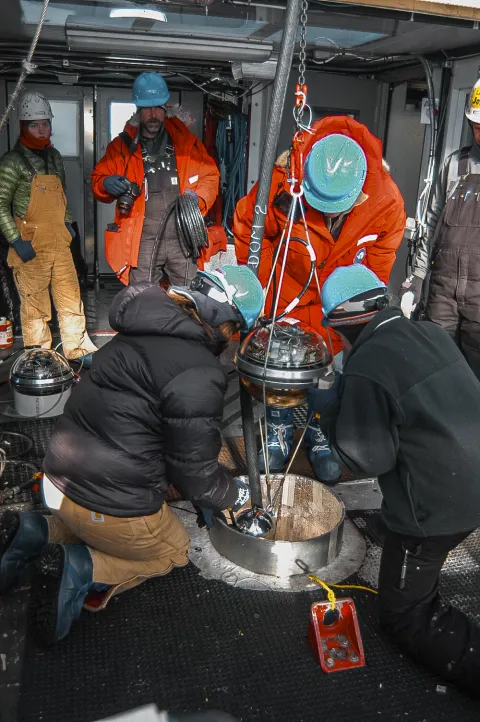
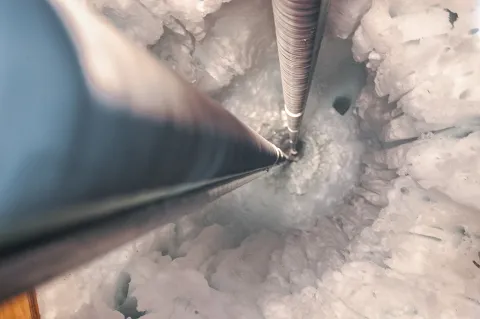
What was the community like?
There was a large community of creatives. The people who were supporting science during the day would spend their afterhours playing music or doing photography. There was an art show at the end of each season where people display their work. They even had a big music festival called Ice Stock — based on the Woodstock concert in New York.
Something about being down there — you could call it being deprived of the sensory overload of cities — that brought out the creativity in people. I even rewrote a Janice Joplin song and sang it at Ice Stock, and I'm not musically inclined at all.
We also could go on guided expeditions to some historical sights on the continent. Because of the cold, these locations were incredibly well-preserved. In one hut, there was a frozen penguin that had been dissected by early explorers; it was still there, intact, on the table from their 1912 expedition. Also, I once visited a penguin rookery.
Each year for New Years Day, there is a parade around the South Pole. It's called the Race Around the World. People run it, cross country ski it and even design floats to drive around it. One year, we designed a working shower on a float. People took turns going in and taking a shower as the platform moved with the parade. Who can say they took a hot shower at the South Pole? Well, we did.
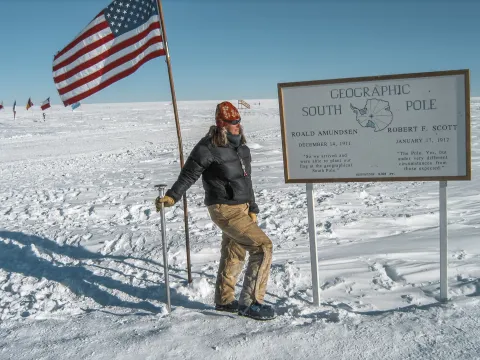
What brought you to South Dakota?
I met my husband Aaron through my work on the South Pole. He was on the construction team that build the new elevated station. He was a fifth-generation rancher from South Dakota. After a few seasons on the ice, he asked what I thought about moving to South Dakota. To me, it seemed more obscure than Antarctica. "Who lives there? What's going on there?" I thought.
But when we did move here in 2007, I found out about the work beginning at Sanford Lab. I just thought... “how strange is that?” Advanced neutrino research was unfolding in both of these places, and I wanted to be a part of it. It felt like connecting the South Pole to our life in South Dakota.
We got married and have a nine-year-old son named Guy. I worked at Devils Tower for a summer, then at an agricultural newspaper and even worked with my husband as a ranch hand. All the while, I had my eye on Sanford Lab.
What is it like working for an underground laboratory?
This year, I landed a job as a warehouse specialist, which is actually very close to what I did in Antarctica. The cargo — high-dollar scientific apparatus being shipped from all across the world — is very similar. Instead of ships and airplanes, though, deliveries arrive on trucks, which is a little more normal.
It’s just a month in, but I like the work. There’s a certain level of comfort returning to something I've done before; I feel that my skillset is a good match. I’m looking forward to adding Sanford Lab to the list of stories I have to tell.
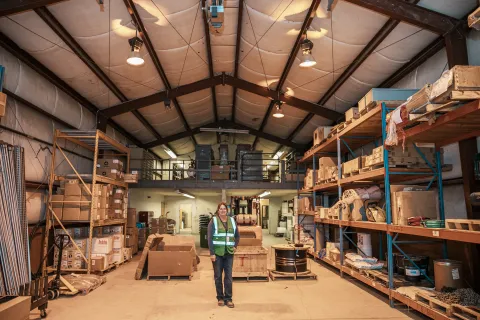
The IceCube Neutrino Observatory is the first detector of its kind, designed to observe the cosmos from deep within the South Pole ice. An international group of scientists responsible for the scientific research makes up the IceCube Collaboration. Encompassing a cubic kilometer of ice, IceCube searches for nearly massless subatomic particles called neutrinos. These high-energy astronomical messengers provide information to probe the most violent astrophysical sources: events like exploding stars, gamma-ray bursts, and cataclysmic phenomena involving black holes and neutron stars.
